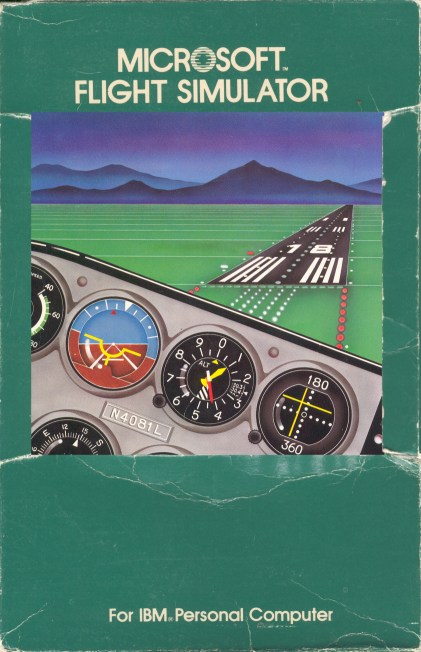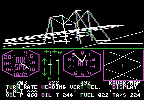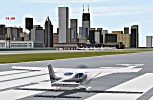The History of Flight
Simulator according to Microsoft
FS 1 and 2 for the IBM PC
Triggered by the great success of
FS1 for the Apple, both the big IBM and a small
software firm from Redmond approached SubLOGIC in 1981
to obtain an exclusive license on a version of Flight
Simulator for the new IBM PC. Eventually the young
entrepreneurs Bruce Artwick and Bill Gates found each
other because, as Artwick stated: "I decided to
go with Microsoft because of its nice small-company
atmosphere (sic!)."
Once again Bill Gates proved his
fine nose for important developments and put all his
marketing skills to make FS a success. Could anybody
have thought that it would become such a boomer?
Incidentally, Bruce Artwick already had a new version
almost ready, this time based on a real airplane and
real world scenery. "All that remained to be
done" was port it to the new IBM PC, which wasnít
easy because of the poor graphic functionality of the
first PCís compared to the other microcomputers on
the market. So, if you ask Microsoft, the history of
Flight Simulator starts in 1982!
 Thus
in November 1982, Microsoft Flight Simulator
Thus
in November 1982, Microsoft Flight Simulator 1.00 hit the shelves as one of the pioneering
entertainment titles. Soon it became one of the most
sought after software for the PC and after nearly 20
years it still is. It even made the Guinness Book of
Records. Over 20 million copies of FS 2000 alone are
reported to be sold. It is also safe to say that the
applicationís demanding hardware needs actually
influenced the landscape of computer development and
sales. A kind of race started between FS and the PC:
every new version of FS demanding more than the
current PC-model could deliver and every new PC-model
and graphics card offering room for enhancements of
FS.
1.00 hit the shelves as one of the pioneering
entertainment titles. Soon it became one of the most
sought after software for the PC and after nearly 20
years it still is. It even made the Guinness Book of
Records. Over 20 million copies of FS 2000 alone are
reported to be sold. It is also safe to say that the
applicationís demanding hardware needs actually
influenced the landscape of computer development and
sales. A kind of race started between FS and the PC:
every new version of FS demanding more than the
current PC-model could deliver and every new PC-model
and graphics card offering room for enhancements of
FS.
Saying that (Microsoft) Flight
Simulator started in 1982 makes some sense in the way
that this version, other that its Apple II/TRS-80
predecessor indeed has most of the characteristics of
our present day simulation, albeit of course much
simpler. As you can see from the picture below,
version 1.01 already features a display as we still
see, with a window to the scenery above and the panel
beneath.

The panel even looks like the
current standard Cessna panel. It contains 8 round
gauges for airspeed, attitude indicator (artificial
horizon), altimeter, turn coordinator, heading
indicator (gyro), rate of climb indicator and
tachometer (rpm). In addition it offers control
position indicators, a magnetic compass, fuel and
temperature meters, gear indicator, clock, NAV and COM
radio and a transponder. A current day FS-pilot would
immediately feel "at home". The only things
that are really missing are ADF/DME equipment and an
autopilot and GPS. But were these already normal on
all real planes at that time?
The scenery, although limited to 4
areas (Chicago, Seattle, Los Angeles and New
York/Boston) depicts a (simple) presentation of the
real world, based on an ingenious coordinate system,
developed by Bruce Artwick. The scenery contains some
simple buildings, bridges and other objects like the
Statue of Liberty and the Space Needle. Some 20
airports are included with correct navigation aids (VOR,
OMI) and ATIS and some runways are equipped with an
Instrument Landing System (ILS).
The simulation can be made even
more realistic by setting environment factors as time
of day, season, clouds, wind and turbulence. The
number of aircraft characteristics considered in the
calculations has been increased to 35. The aircraft
modelled is a real life Cessna 182 with retractable
gear. Is there really anything new under the sun of
our current version? The introduction of the very good
100 page manual rightfully speaks of a second
generation, real time flight simulation.

In version 1 the view was limited
to straight ahead or down (radar) view, both with the
possibility of zooming in and out. An outside view
(spot plane, tower) is not yet present and of course
the measure of detail is much less than today.
In later versions you can view around in 8 directions.
The very first version supports 8 color CGA, although
the simulator was very flyable with a b/w monitor.
Itís truly amazing how the
sorcerers of SubLOGIC could get that all working
within the constraints of a first generation 4.77 MHz
IBM PC with 64K memory and a 360K floppy. Compare that
to our present day 1,5 GHz Pentium IV with 512M memory
and a 60G disk!
Also included in the package was an
expanded version of the "British Ace" WW1
fighting game. already present in the very first FS
for the Apple II and TRS-80. No less than 6 enemy
fighters, amongst which 3 Fokker planes, try to
prevent you from bombing the enemy factories and fuel
depots.

In a rapid succession new releases
were brought out by the Microsoft/SubLOGIC tandem,
each offering new or improved functionality and bug
fixes (yes, in that time too). See the table below.

